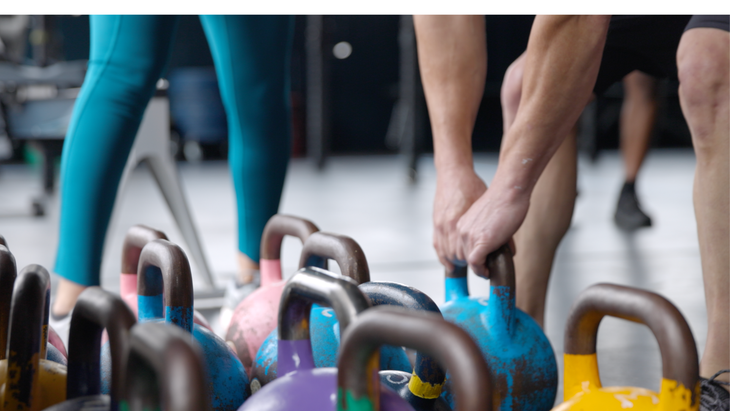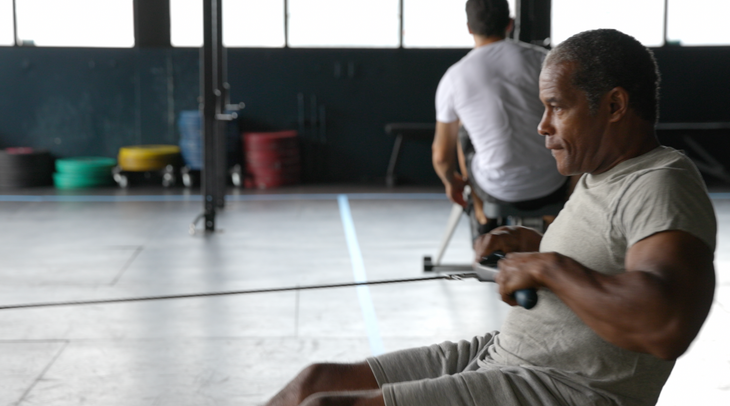“], “filter”: { “nextExceptions”: “img, blockquote, div”, “nextContainsExceptions”: “img, blockquote, a.btn, a.o-button”} }”>
Heading out the door? Read this article on the new Outside+ app available now on iOS devices for members!
>”,”name”:”in-content-cta”,”type”:”link”}}”>Download the app.
It’s noon on Sunday at UpDog studio on Broadway and 102nd Street in Manhattan. How crowded could class be at a recently opened yoga studio?
Packed.
The 900-square-foot practice room is filled by the time the teacher walks to the front of the class. As she welcomes the 21 students, everyone—mostly but not exclusively women—smiles back at her. Racks are filled with tidily stacked bolsters, blankets, and blocks that promise all the support and comfort practitioners could need. Four-foot high windows let the light stream onto the many potted plants, among them a baby rubber plant and an Australian Umbrella Tree.
“We love creating a welcoming, warm environment in this space,” says Nicole Pavone, who co-owns UpDog and its other location in Harlem with her partner, Jordan McLaughlin. “We want it to be a home away from home!”
Twenty four hours earlier and 1,033 miles away, Desiree Bice taught her weekend yoga class at the Bell Road YMCA in Montgomery, Alabama. “No windows, unfortunately,” she says as she describes her practice space at the Y. “But we do have blankets, blocks, and straps. And mats in case someone didn’t bring them, although most of our students usually do.”
The Bell Road Y exercise studio may not have natural light or, for that matter, Australian Umbrella Trees. But it does have other amenities that few yoga studios can match. That includes an Olympic-size swimming pool, a fully stocked weight training area, and an indoor bicycling studio with 20 bikes. The Y also offers 12 to 15 fitness classes a day, spanning literally A to Z with classes from aqua fitness to Zumba. There’s also tai chi, Pilates, and specialized classes such as RockSteady boxing, designed for those with Parkinson’s Disease.
The gym also boasts a full schedule of yoga classes—including chair, flow, restorative, and the general all-levels classes that Bice teaches. When she describes it as “all levels,” she means it. “I could have someone who’s taking their very first yoga class, or someone who’s been doing it for 20 years,” says Bice. “That’s a challenge for a teacher, absolutely.” It’s a challenge many gym yoga teachers are accustomed to navigating.
Although some students tend to gravitate toward yoga studios for a specific teachers, the vibe, or the community, there’s zero reason to ignore or dismiss yoga options at gyms—including if you’re new to yoga.
Different Can Be Good
“A good yoga teacher will always arrive and give a good class, regardless of where they’re teaching,” says Pavone. That said, there are undeniable differences between the studio vibe and a gym. And, as Pavone explains, much of that relates to environment.
Temperature is one factor—gyms typically keep it cooler than many yoga studios at 68 to 72 degrees Fahrenheit, which is a pretty standard temperature range. Some can get even cooler.
When she began her yoga teaching career, Barbara Ruzansky found that “temperature was one of the biggest issues for me.” She remembers that at one chilly gym, “I would wear a down jacket, and many of the people in the class were bundled up.” After teaching yoga at gyms and corporate fitness centers, she eventually opened her own studio, West Hartford Yoga, where she can adjust the temperature however she likes.
Also, Pavone explains, the practice space at a gym with yoga classes is likely to be multipurpose. “You might have Zumba in that same room, kettlebells, or a boot camp class. So it’s not set up specifically for the yoga mindset,” she explains. True enough, as anyone who has visited a typical health club can attest. At a gym, the lights can be bright, the music loud, and the clanging and thudding of weights a constant background soundtrack.

But keeping the yoga classes connected to the larger gym environment is also how members—in particular those who have never taken yoga before—might be enticed to the mat.
The practice space at the Y where Bice teaches is partially visible to other gym patrons. This, she believes, has helped spark interest in her classes. “Guys lifting or running on the treadmill, or people playing pickleball on our courts, they walk by and see a yoga class going on, they might want to try it,” she says.
Perhaps because there are first timers dropping in, the demographics of Bice’s class at the Y mirror those of the Greater Montgomery community. “Young, old, majority women but some men, black, white, some military, some non military,” she explains.
Of course, if you’ve found kindred spirits in a studio, that’s a beautiful thing. But don’t exclude the possibility of trying a different teacher or a different style of yoga—and finding community in a broader audience.
“We need to take our practice to new places sometimes,” says Tory Schaefer, Senior Director of Class Education and Yoga at the fitness chain Life Time. A longtime teacher and former manager of a yoga studio in Minneapolis, Schaefer explains that each of its 175 clubs nationwide offer yoga—many with robust schedules of up to 70 to 75 classes a week. The chain offers several types of yoga classes—Surrender (Yin), Root (Hatha), Sol (Guided Vinyasa), Flow Vinyasa, Fire (HIIT), and Warrior (Sculpt).
“I would say yoga is not only one of our more popular brands within Life Time, it’s been our most consistent,” says Schaefer. Participation in yin and in meditation classes, Schaefer says, is “skyrocketing.”
Other major fitness chains offer robust schedules of yoga classes as well. At the Equinox fitness club in Hudson Yards, Manhattan, for example, there are an average of three yoga classes per day, and the styles offered vary among vinyasa, yin, power, and restorative. On the other side of the country, the West Hollywood, California, location of another well-known gym chain, Crunch Fitness, offers several classes each day in vinyasa, flow, or power yoga.
Another advantage of practicing at a gym? You’re at a gym.

“I think what the gym experience affords a yoga practitioner is the opportunity to make yoga the main entree or the appetizer,” says Max Preston Kennedy, a Manhattan-based yoga instructor who has taught at both studios and gyms. “What if you went for a swim first, and then went to yoga? Or vice versa. Don’t only explore the yoga classes being offered. Definitely explore other things.”
Studio Yoga Class or Gym Yoga Class? Just Go!
Although gyms—particularly the larger ones—have rules that can preclude the kind of informality and intimacy found at smaller studios. “A true boutique experience,” is how McLaughlin describes what he and Nicole are seeking to create. “Small, local. We want people to know they’re walking into a studio owned by people in the community, that care about the community.”
That kind of community is certainly a lovely thing. Although there’s an argument to be made for changing things up.
“The longer we practice yoga,” Schaefer says, “the more we tend to set expectations, the more we tend to think, ‘If it’s not my teacher, not my club or studio, it’s not going to be as good.’” He notes the importance of getting out of our routine. Or, as he explains, “those habitual patterns that create deep ravines in our mind.”
It’s an approach that’s aligned with various principles of yoga philosophy, including the value of non-attachment (aparigraha), awareness of ruts or patterned behavior (samskaras), and self-study (svadyaya).
“There’s something beautiful to learn from every yoga setting,” agrees Schaefer. “That’s one of the great things about the practice.”
Of course, if you’ve been practicing yoga at a studio for years and found kindred spirits, that’s a beautiful thing. But don’t exclude the possibility of trying a different teacher, style of yoga, and community in a broader audience.
“You’ll get a different experience, and that’s a good thing,” says Ruzansky. She encourages participation in either setting. “Wherever you can practice yoga, it’s a good thing,” she says. “Go!”













